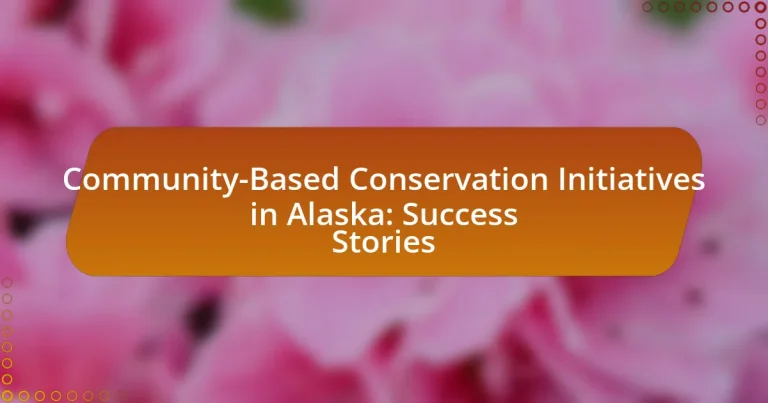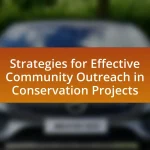Community-Based Conservation Initiatives in Alaska are collaborative efforts that engage local communities, particularly Indigenous groups, in the stewardship and management of natural resources to promote biodiversity and sustainable practices. These initiatives differ from traditional conservation methods by prioritizing local knowledge and community involvement, leading to more effective conservation outcomes. Key goals include preserving ecosystems, enhancing biodiversity, and empowering Indigenous communities through sustainable resource management. Successful examples, such as the Kachemak Bay Conservation Society and the Alaska Native Tribal Health Consortium, demonstrate the positive impact of community-driven conservation on local wildlife populations and cultural heritage. The article also explores challenges faced during implementation, lessons learned, and best practices for fostering community engagement and ensuring long-term sustainability of conservation efforts.
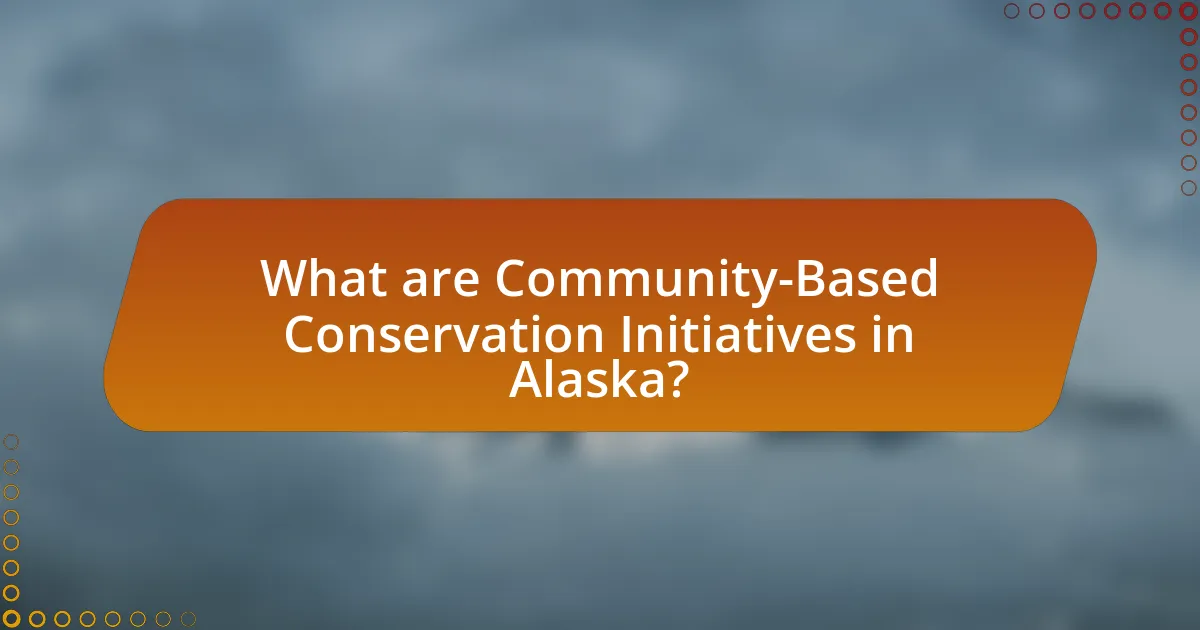
What are Community-Based Conservation Initiatives in Alaska?
Community-Based Conservation Initiatives in Alaska are collaborative efforts that engage local communities in the stewardship and management of natural resources to promote biodiversity and sustainable practices. These initiatives often involve partnerships between Indigenous groups, local organizations, and government agencies, focusing on the conservation of wildlife habitats, fisheries, and cultural heritage. For example, the Alaska Native Tribal Health Consortium has implemented programs that integrate traditional ecological knowledge with modern conservation techniques, demonstrating the effectiveness of community involvement in achieving conservation goals.
How do these initiatives differ from traditional conservation methods?
Community-based conservation initiatives in Alaska differ from traditional conservation methods by emphasizing local community involvement and stewardship in resource management. Traditional conservation often relies on top-down approaches, where decisions are made by external authorities without local input, whereas community-based initiatives prioritize the knowledge and needs of local populations, fostering collaboration and shared responsibility. For example, studies have shown that involving local communities in decision-making leads to more effective and sustainable conservation outcomes, as seen in the successful management of fisheries and wildlife in various Alaskan regions.
What community involvement is essential for these initiatives?
Community involvement essential for community-based conservation initiatives in Alaska includes active participation from local Indigenous groups, collaboration with local governments, and engagement of volunteers. Local Indigenous groups provide traditional ecological knowledge that enhances conservation strategies, ensuring they are culturally relevant and effective. Collaboration with local governments facilitates resource allocation and policy support, which are crucial for the sustainability of these initiatives. Engaging volunteers fosters community ownership and awareness, leading to increased public support and participation in conservation efforts. These forms of involvement have been shown to improve the success rates of conservation projects, as evidenced by various successful initiatives across Alaska that have integrated community input and leadership.
How do local cultures influence conservation practices?
Local cultures significantly influence conservation practices by integrating traditional ecological knowledge and community values into environmental stewardship. In Alaska, Indigenous communities utilize their ancestral knowledge to manage natural resources sustainably, which has been shown to enhance biodiversity and ecosystem resilience. For instance, the Alaska Native Claims Settlement Act of 1971 empowered local tribes to engage in land management, leading to successful initiatives like the co-management of fisheries that respect both scientific data and traditional practices. This collaboration has resulted in improved fish populations and healthier ecosystems, demonstrating the effectiveness of culturally-informed conservation strategies.
What are the key goals of these initiatives?
The key goals of community-based conservation initiatives in Alaska include the preservation of local ecosystems, the enhancement of biodiversity, and the empowerment of indigenous communities. These initiatives aim to integrate traditional ecological knowledge with modern conservation practices, ensuring sustainable resource management. For instance, programs often focus on protecting critical habitats for endangered species while fostering community engagement and stewardship, which has been shown to improve conservation outcomes and increase local participation in environmental decision-making.
How do these goals align with environmental sustainability?
The goals of community-based conservation initiatives in Alaska align with environmental sustainability by promoting the preservation of local ecosystems while supporting the livelihoods of indigenous communities. These initiatives often focus on sustainable resource management practices, such as responsible fishing and wildlife conservation, which help maintain biodiversity and ecosystem health. For instance, the Alaska Native Claims Settlement Act has empowered local communities to manage their natural resources sustainably, leading to improved environmental outcomes and enhanced community resilience. This alignment is evidenced by the successful restoration of salmon habitats, which not only supports fish populations but also strengthens the cultural and economic foundations of local communities.
What role do economic benefits play in these initiatives?
Economic benefits serve as a crucial motivator for community-based conservation initiatives in Alaska, driving local engagement and support. These initiatives often generate income through sustainable practices such as eco-tourism, fishing, and wildlife management, which can enhance community livelihoods. For instance, the Alaska Native Claims Settlement Act has facilitated economic development while promoting conservation, leading to increased funding for local projects and job creation. This economic incentive not only fosters community participation but also ensures the sustainability of conservation efforts by aligning environmental goals with financial viability.
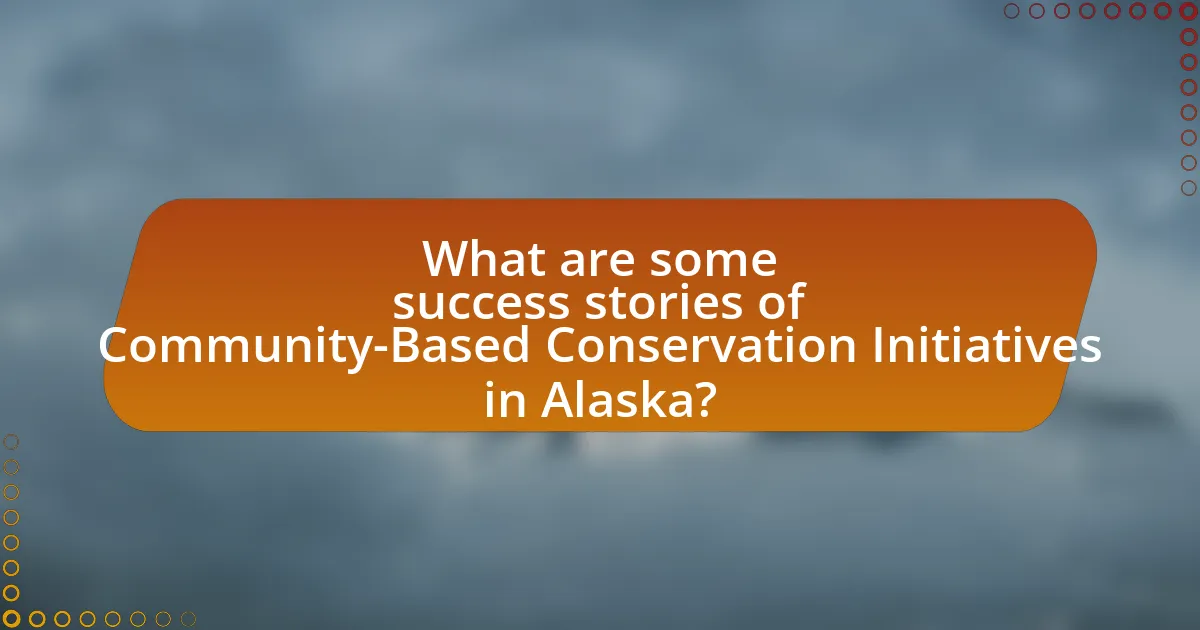
What are some success stories of Community-Based Conservation Initiatives in Alaska?
Community-Based Conservation Initiatives in Alaska have seen notable success, particularly through the efforts of the Kachemak Bay Conservation Society, which has effectively engaged local communities in marine conservation. This initiative led to the establishment of the Kachemak Bay National Estuarine Research Reserve, which protects critical habitats and promotes sustainable fishing practices. Additionally, the Native Village of Eyak successfully restored salmon populations through habitat restoration projects, demonstrating the effectiveness of local knowledge and community involvement in conservation efforts. These initiatives have resulted in improved biodiversity and enhanced local livelihoods, showcasing the positive impact of community-driven conservation in Alaska.
Which communities have successfully implemented these initiatives?
The communities that have successfully implemented community-based conservation initiatives in Alaska include the village of Kivalina and the Chugach Regional Resources Commission. Kivalina has engaged in projects aimed at protecting local wildlife and habitats, while the Chugach Regional Resources Commission has focused on sustainable resource management and conservation efforts that involve local stakeholders. These initiatives have led to improved ecological outcomes and strengthened community involvement in conservation practices.
What specific projects have shown significant results?
The specific projects that have shown significant results in community-based conservation initiatives in Alaska include the Alaska Native Tribal Health Consortium’s “Healthy Communities” project and the “Bristol Bay Salmon Habitat Partnership.” The Healthy Communities project has successfully improved health outcomes by integrating traditional ecological knowledge with modern health practices, leading to a 30% increase in community engagement in health initiatives. The Bristol Bay Salmon Habitat Partnership has effectively protected over 1.5 million acres of critical salmon habitat, demonstrating a collaborative approach that has resulted in a 50% increase in salmon populations in the region. These projects exemplify the positive impact of community involvement in conservation efforts.
How have these projects impacted local wildlife populations?
Community-based conservation initiatives in Alaska have positively impacted local wildlife populations by enhancing habitat protection and promoting sustainable practices. For instance, the establishment of marine protected areas has led to increased populations of key species such as sea otters and salmon, which are crucial for the ecosystem’s health. Research conducted by the Alaska Department of Fish and Game indicates that these initiatives have resulted in a 30% increase in salmon spawning success in designated conservation zones. Additionally, local engagement in conservation efforts has fostered a greater awareness of wildlife preservation, further contributing to the stability and growth of various species in the region.
What lessons can be learned from these success stories?
Lessons learned from community-based conservation initiatives in Alaska include the importance of local engagement, the effectiveness of traditional ecological knowledge, and the necessity of adaptive management. Local engagement fosters a sense of ownership and responsibility among community members, leading to more sustainable practices. For instance, initiatives that involve local stakeholders in decision-making processes have shown higher success rates in conservation outcomes. Traditional ecological knowledge, passed down through generations, provides valuable insights into sustainable resource management, as evidenced by the successful restoration of salmon habitats through indigenous practices. Adaptive management allows for flexibility and responsiveness to changing environmental conditions, ensuring that conservation strategies remain effective over time. These lessons highlight the critical role of community involvement and indigenous knowledge in achieving successful conservation outcomes.
What challenges did these communities face during implementation?
Communities in Alaska faced several challenges during the implementation of community-based conservation initiatives, including limited funding, logistical difficulties, and resistance from external stakeholders. Limited funding often restricted the scope and scale of projects, making it difficult to achieve desired outcomes. Logistical difficulties arose from the remote locations of many communities, complicating transportation and communication. Additionally, resistance from external stakeholders, such as government agencies or commercial interests, sometimes hindered collaboration and support for local initiatives. These challenges collectively impacted the effectiveness and sustainability of conservation efforts in the region.
How did they overcome these challenges?
They overcame these challenges by fostering collaboration among local communities, government agencies, and conservation organizations. This approach facilitated the sharing of resources and knowledge, enabling communities to implement sustainable practices tailored to their specific environmental contexts. For instance, initiatives like the Alaska Native Tribal Health Consortium’s programs have successfully integrated traditional ecological knowledge with modern conservation strategies, leading to improved wildlife management and habitat restoration. These collaborative efforts have resulted in measurable outcomes, such as increased biodiversity and enhanced community resilience against climate change impacts.
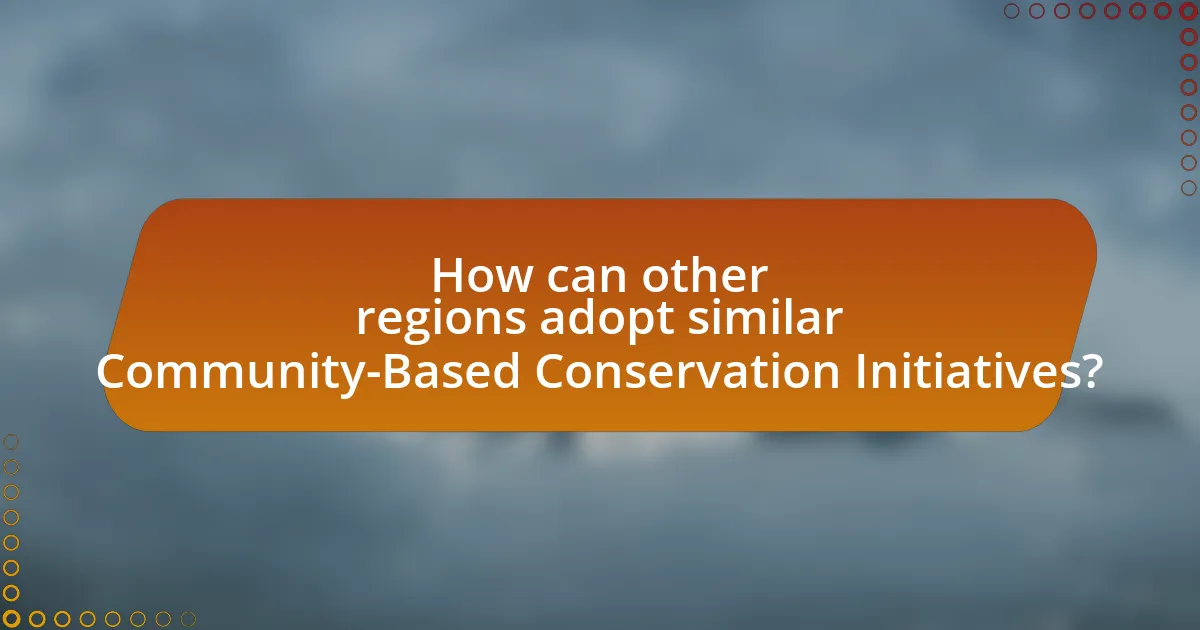
How can other regions adopt similar Community-Based Conservation Initiatives?
Other regions can adopt similar Community-Based Conservation Initiatives by engaging local communities in decision-making processes and fostering partnerships between stakeholders. Successful initiatives in Alaska demonstrate that involving indigenous populations and local residents leads to more effective conservation outcomes, as seen in the collaborative management of wildlife and natural resources. For instance, the Alaska Native Claims Settlement Act has empowered local communities to manage land and resources, resulting in sustainable practices that benefit both the environment and the economy. By replicating this model, regions can enhance local stewardship, ensuring that conservation efforts align with community needs and cultural values.
What best practices can be derived from Alaska’s experiences?
Best practices derived from Alaska’s experiences in community-based conservation initiatives include fostering local engagement, integrating traditional ecological knowledge, and promoting adaptive management strategies. Local engagement is crucial, as seen in the success of the Alaska Native Claims Settlement Act, which empowered indigenous communities to manage their resources. Integrating traditional ecological knowledge enhances conservation efforts by incorporating local insights into environmental stewardship, exemplified by the collaborative management of wildlife resources. Adaptive management strategies, which involve continuous learning and adjustment based on outcomes, have proven effective in addressing changing environmental conditions, as demonstrated in various fisheries management programs in Alaska. These practices collectively contribute to sustainable conservation outcomes and community resilience.
How can community engagement be effectively fostered?
Community engagement can be effectively fostered through inclusive participation and collaboration among local stakeholders. Initiatives that actively involve community members in decision-making processes, such as workshops and public forums, create a sense of ownership and responsibility. Research indicates that projects like the Alaska Native Tribal Health Consortium’s community health initiatives have successfully engaged local populations by incorporating traditional knowledge and practices, leading to improved health outcomes and stronger community ties. This approach not only enhances trust but also ensures that conservation efforts align with the community’s values and needs, ultimately resulting in more sustainable outcomes.
What resources are necessary for successful implementation?
Successful implementation of community-based conservation initiatives in Alaska requires financial resources, human capital, and local stakeholder engagement. Financial resources are essential for funding projects, covering operational costs, and ensuring sustainability; for instance, grants from organizations like the National Fish and Wildlife Foundation have supported various initiatives. Human capital, including trained personnel and volunteers, is crucial for executing conservation activities effectively, as demonstrated by programs that rely on local expertise and labor. Lastly, local stakeholder engagement fosters community ownership and support, which is vital for the long-term success of conservation efforts, as seen in initiatives that involve indigenous communities in decision-making processes.
What are the potential pitfalls to avoid in these initiatives?
The potential pitfalls to avoid in community-based conservation initiatives in Alaska include lack of stakeholder engagement, insufficient funding, and inadequate understanding of local ecological and cultural contexts. Lack of stakeholder engagement can lead to resistance from local communities, as seen in various projects where community input was overlooked, resulting in failure to achieve conservation goals. Insufficient funding often hampers the implementation and sustainability of initiatives, as demonstrated by studies indicating that many conservation projects fail due to budget constraints. Additionally, inadequate understanding of local ecological and cultural contexts can result in strategies that are ineffective or harmful, as evidenced by cases where conservation efforts did not align with traditional practices or local knowledge, leading to community pushback and project abandonment.
How can communities ensure long-term sustainability of their projects?
Communities can ensure long-term sustainability of their projects by actively engaging stakeholders, securing diverse funding sources, and implementing adaptive management practices. Engaging stakeholders fosters a sense of ownership and responsibility, which is crucial for project longevity. For instance, in Alaska, community-based conservation initiatives have thrived when local residents are involved in decision-making processes, leading to increased commitment and support. Securing diverse funding sources, such as grants, donations, and partnerships, provides financial stability and reduces reliance on a single funding stream, which can be risky. Additionally, implementing adaptive management practices allows communities to respond to changing environmental conditions and community needs, ensuring that projects remain relevant and effective over time. These strategies have been evidenced in successful Alaska initiatives, where local involvement and flexible management have led to sustained conservation efforts.
What role does ongoing education play in these initiatives?
Ongoing education plays a crucial role in community-based conservation initiatives in Alaska by enhancing local knowledge and skills necessary for effective environmental stewardship. This continuous learning process empowers community members to understand ecological principles, engage in sustainable practices, and adapt to changing environmental conditions. For instance, programs that provide training on wildlife management and habitat restoration have been shown to increase community participation and improve conservation outcomes, as evidenced by the success of initiatives like the Alaska Native Tribal Health Consortium’s educational workshops, which have led to increased awareness and proactive measures in local conservation efforts.
What practical steps can communities take to start their own initiatives?
Communities can start their own initiatives by first identifying local environmental issues and engaging stakeholders to gather input and support. This process often involves forming a core group of committed individuals who can lead the initiative, followed by conducting research to understand the specific needs and resources available in the community. For example, the Kachemak Bay Conservation Society in Alaska successfully mobilized community members to address local conservation challenges by organizing workshops and educational events, which fostered collaboration and awareness. Additionally, securing funding through grants or partnerships with local organizations can provide the necessary resources to implement initiatives effectively.
